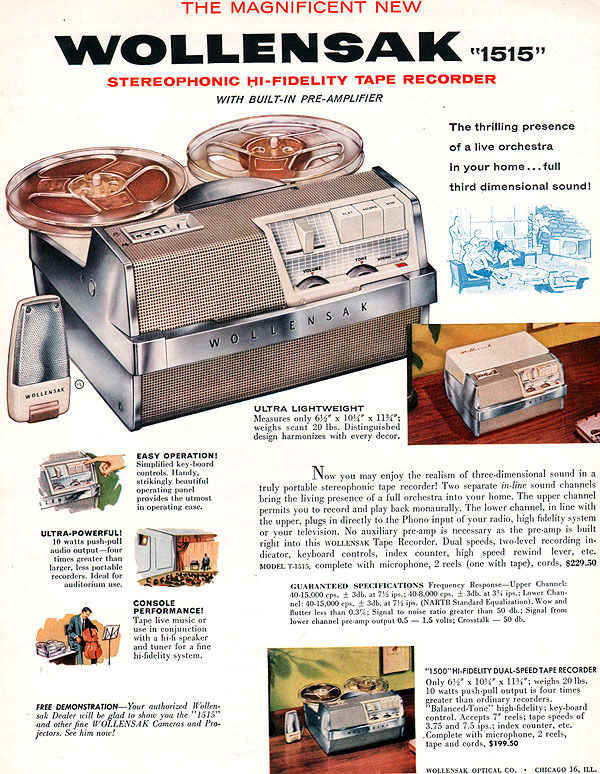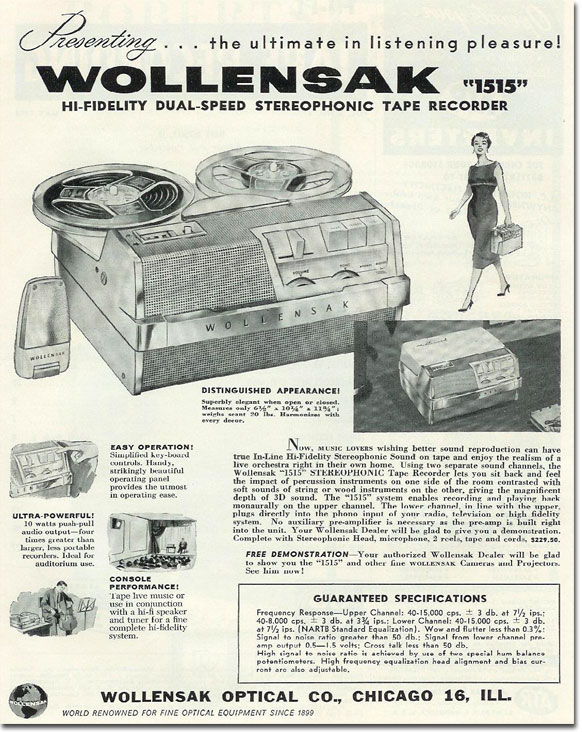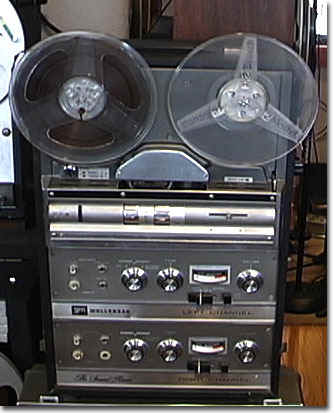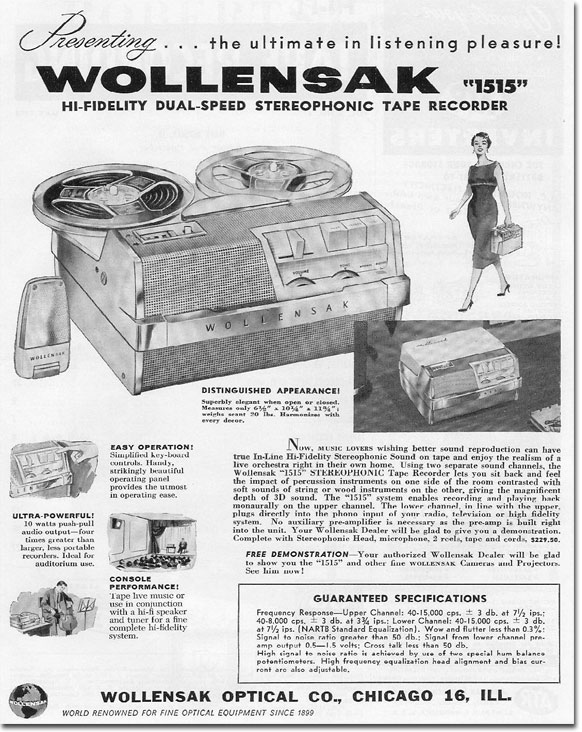
From Wollensak
Recorder History and Guide
by:
stenkbomm
I
suppose it might be helpful to write a Wollensak recorder guide while my
memory still retains some details. I was a Wollensak Factory Authorized
& Trained service facility manager and technician until their end.
Wollensak
started out as a lens manufacturer over 100 years ago. They provided
lenses and lens components to all the major American manufacturers during
the 20th century until the Japanese took over the market. They also made
some shutters and formed a partnership with The Revere Camera Company that
led to them offering some cameras (mostly 8MM) under their name in the 50s
and early 60s.
That
partnership with Revere would have profound implications for both
companies when Revere, like many other optical companies (Ampro, TDC, Bell
& Howell, etc.) of the day (Early 50s) started venturing into making
tape recorders. Revere's first offerings were mundane but they came up
with a design that was a winner and would remain the basis for their
machines for decades.
Enter
Wollensak. They took the basic mechanism, designed a modern "aircraft
construction" shell to house it, a simple 3-key and slider control
system, and a compact amplifier. The resulting unit was small, light,
stylish, and an instant hit. The "1500 series" was born.
Over
the next few years Wollensak/Revere would make refinements and optional
versions of it.
The
original T-1500 was a half-track (2-track mono) recorder with a unique
(for the time) amplifier, using an interstage transformer instead of a
phase inverter to drive its push-pull 12AB5 amplifier. It had Record,
Play, and Public Address capability which made it a hit with lecturers,
schools, etc. The amplifier is often seen on eBay being sold as a
"guitar amp" or other non-tape recorder usage.
3M
acquired Revere/Wollensak as a perfect companion to its tape manufacturing
business. The division eventually became known as the "Mincom
Division" with its headquarters in St. Paul, MN. The new parentage
allowed research and innovation.
Variations
of the 1500 quickly appeared. One of the first was the T-1515, a Stereo
version. The 1515 replaced the standard mono head with a stereo head and
added a small preamplifier for the second channel. By plugging the unit
into a stereo system or adding a satellite speaker/amplifier the then-new
Stereo tapes could be played. Recording was still only mono, however.
This
was quickly followed by the T-1515-4 as the industry went to 4-track
tapes. The head system was redesigned to include the new head and to
provide a selector that moved the head up and down. The 4-track setting
allowed for playing prerecorded 4-track stereo tapes. There was also a
2-track setting that lowered the head slightly so it tracked 2-track tapes
without the loss in channel one that was common to other brands. A 3rd
position allowed for recording 4-track mono by shifting the active
(recording) poles to the different parts of the tape to accomplish this.
Others would adopt this approach too, including Webcor & Akai/Roberts.
One
of the rarest was the TS-1520/T-1700, which could run from standard AC or
from a 12 volt DC (car) battery thanks to their built-in vibrator or
inverter systems. (This unit should not be confused with the later 1520AV)
This allowed location recording of a better quality than the average
existing transistor and clockwork units then available but improvements in
these designs made it obsolete very quickly.
Small
internal improvements were made, mostly to the idler wheel carriers and
later to the rewind arm but the drive mechanism was essentially still the
original Revere design.
There
was also an "economy" series of the two then-current 1500 models
(T-1500 & T-1515-4): the "1400 series". The T-1400 and
T-1440 were identical to the 1500 units except they were painted a dark
gray instead of having the brushed or polished bare aluminum of the
regular units.
For
the "deluxe" end of the market they redesigned the shell and
added push buttons and relays to make soft-touch controls and the
possibility of remote operation available. The T-1600 & T-1616 were
never great sellers but did look spiffy and added prestige.
The
demand for mono recorders was falling, however, and what there was for it
was increasingly being filled by cheaper units from Japan. Wollensak
needed a stereo RECORDER to compete.
The
engineers took the base mechanism and redesigned it to incorporate
power-assisted operation and a new 2-channel amplifier. The case got a
totally new look and side-mounted speakers. The T-1580 was an instant
success and had fairly good specs for the price. Ads with name musicians
appeared in several publications. It retained all the traditional
features, including PA ability. A mono version, the T-1570 never caught
on, but the 1580 remained in the catalog for a few years.
The
1580 was expanded into a large upright unit seemingly inspired by the
popular Roberts (Akai) units of the day. The T-1980 "Sound Room"
was mechanically and electronically mostly identical to the 1580 but
bigger and more impressive, with meters instead of the neon indicators
used until then.
The
1980 was also offered as a build-in version without the carry case as the
T-1780.
The
1580 mechanism was also used, with different amplifiers, cases, in
lower-priced or later models such as the T-1280.
In
an effort to keep a foot in the low-end market a totally new design, the
T-524 was offered but never did well.
During
all this the original 1500 was still selling well, especially to schools
and corporations. 3M renamed it the T-1500AV but otherwise it remained
pretty much the same until they decided to update it to a transistor
(solid-state) amplifier and give it a small meter. It was then dubbed the
T-1500SS.
Price
had become a big issue for the consumer lines and production costs on the
old 1500 mechanism and case had gone up, so a new series was designed for
the consumer market - the 5000 series.
The
new designs were compact and rectangular. A reel on each side with a small
control console between them. They could sit on bookshelves or be hung on
a wall. A simple mechanism, plastic parts, and power-operated push button
controls made for a lighter unit. All were solid-state. Models ranged from
full portables with plastic cases to wooden-cased models with detachable
wing or shelf speakers. With the exception of one mono model all were
stereo. The first series was the 5200/5300 series (5150 for the mono
version) and a later series with mechanical improvements and a headphone
jack was the 5700/5800 series.
T-1500
- the original Revere-based design introduced in 1956. Offered for 10
years with various cosmetic changes/refinements.
T-1500AV
- "Industrial" version of original (1965)
T-1500SS
- The solid state update of the original design. (1967)
T-1515
- The 1958 "stereo" offering.
T-1515-4
- The late 1959 update of the T-1515
T-1520/TS-1520
- AC/12 Volt car model. (1960-2)
T-1520AV
- The updated (final) AV model. Adds Auto Level Recording (ALR) (1969-81)
T-1570
- Mono version of T-1580 (1962)
T-1580
- First Stereo recorder. (1962-6)


|